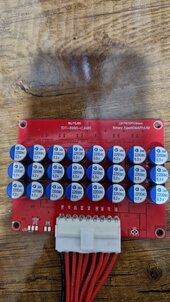So ive got 8 100ah (supposedly) cells from great power which came from a 48v 200ah battery that had 1 bad cell. I dont know if these are grade b or c. And i dont have a way to capacity test each. They are all made in either 2022 and 2023. As you guys can see in the screenshot they are all right now fully charged between 3.45 and 3.55 approx.
Im not getting full capacity but around 75-80 ah because when the lowest cell reaches 2.5 the highest is still 3.15 and the others between 3 and 3.1. What should i do step by step to top balance them knowing they may have diffrent capacities.(they are the same sorts of cells)
If i where to parrallel them now while they are full wont the weaker cell make the other ones also weaker? Or can you top balance cells in parrallel even if the cells arent the same capacity. I would love to see some detailed info about this. Ive been searching here and on google but im not finding my exact situation it feels.
Thanks
Im not getting full capacity but around 75-80 ah because when the lowest cell reaches 2.5 the highest is still 3.15 and the others between 3 and 3.1. What should i do step by step to top balance them knowing they may have diffrent capacities.(they are the same sorts of cells)
If i where to parrallel them now while they are full wont the weaker cell make the other ones also weaker? Or can you top balance cells in parrallel even if the cells arent the same capacity. I would love to see some detailed info about this. Ive been searching here and on google but im not finding my exact situation it feels.
Thanks
Attachments
Last edited:





